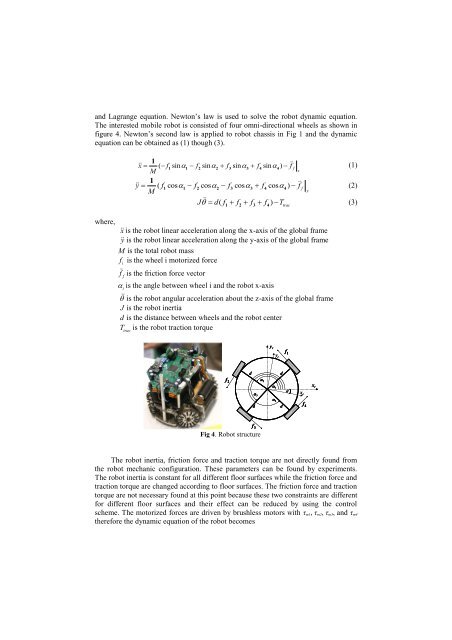Skuba 2011 Extended Team Description - Small Size Robot League
Skuba 2011 Extended Team Description - Small Size Robot League
Skuba 2011 Extended Team Description - Small Size Robot League
Create successful ePaper yourself
Turn your PDF publications into a flip-book with our unique Google optimized e-Paper software.
and Lagrange equation. Newton’s law is used to solve the robot dynamic equation.<br />
The interested mobile robot is consisted of four omni-directional wheels as shown in<br />
figure 4. Newton’s second law is applied to robot chassis in Fig 1 and the dynamic<br />
equation can be obtained as (1) though (3).<br />
where,<br />
1<br />
x � ( � f1 sin�1 � f2 sin� 2 � f3 sin� 3 � f4 sin �4<br />
) � f f<br />
M<br />
x<br />
(1)<br />
1<br />
y � ( f1 cos�1 � f2 cos� 2 � f3 cos� 3 � f4 cos �4<br />
) � f f<br />
M<br />
y<br />
(2)<br />
J� � d( f � f � f � f ) � T<br />
(3)<br />
1 2 3 4 trac<br />
x is the robot linear acceleration along the x-axis of the global frame<br />
y is the robot linear acceleration along the y-axis of the global frame<br />
M is the total robot mass<br />
f is the wheel i motorized force<br />
i<br />
f f is the friction force vector<br />
�i is the angle between wheel i and the robot x-axis<br />
� is the robot angular acceleration about the z-axis of the global frame<br />
J is the robot inertia<br />
d is the distance between wheels and the robot center<br />
T is the robot traction torque<br />
trac<br />
f<br />
2<br />
Fig 4. <strong>Robot</strong> structure<br />
The robot inertia, friction force and traction torque are not directly found from<br />
the robot mechanic configuration. These parameters can be found by experiments.<br />
The robot inertia is constant for all different floor surfaces while the friction force and<br />
traction torque are changed according to floor surfaces. The friction force and traction<br />
torque are not necessary found at this point because these two constraints are different<br />
for different floor surfaces and their effect can be reduced by using the control<br />
scheme. The motorized forces are driven by brushless motors with τm1, τm2, τm3, and τm4<br />
therefore the dynamic equation of the robot becomes<br />
d<br />
��<br />
� 3<br />
d<br />
f<br />
3<br />
��<br />
� 2<br />
y r<br />
y e<br />
��<br />
� 1<br />
��<br />
� 4<br />
d<br />
d<br />
f<br />
1<br />
��<br />
x e<br />
f<br />
4<br />
x r


